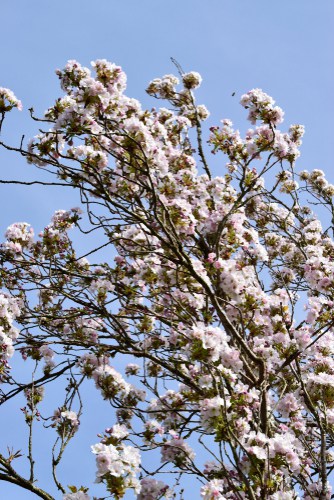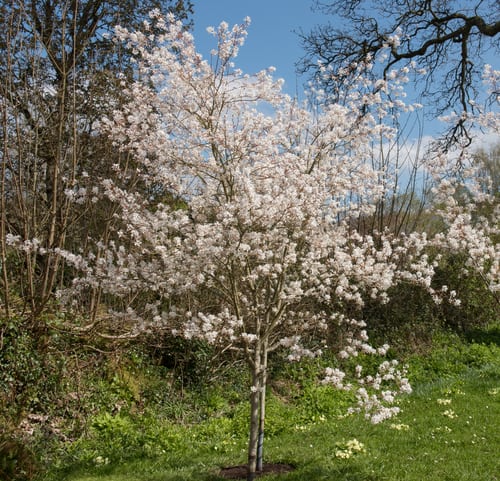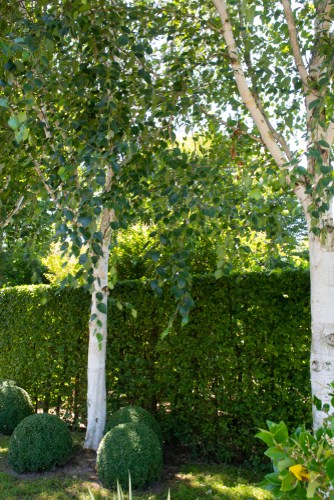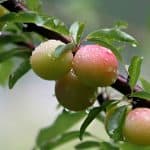Last updated on May 25th, 2022
Our site is reader supported, this means we may earn a small commission from Amazon and other affiliates when you buy through links on our site.
We think every garden should have a tree as they provide cover for wildlife, shade on a hot summer day and some can even provide edible fruits. The good news is no garden is too small if you buy the right tree and some can even be grown in pots
If you have a small garden and are looking for some trees, not just to add some colour but perhaps fruit and stunning foliage, then these top 10 trees for small gardens will offer the perfect solution. Some are evergreen and work well as informal screening while others provide much-needed spring colour like the flowering cherry, there are upright varieties, and also the Golden Rain tree that looks absolutely stunning with its drooping yellow flowers.
1. Magnolia Yellow River – Yulan Magnolia

Known for its beautiful yellow flowers, this small tree is an ideal addition to any garden thanks to the sweet fragrance it produces and the butter yellow flowers you will see. The tree stands upright and cultivates the shape of a goblet with long flowers that can get up to 15cm when they mature. We have had one planted for around 5 years in our garden and it is about 8ft tall.

The design of the petals looks very similar to a Lily. Such trees create dramatic scenes in your springtime garden as the yellow flowers fade softly to white. These trees can reach up to 5m tall and 3m wide once fully established.

They require full sun to partial shade but will grow most prolifically if you keep the soil slightly acidic and moist. They do require well-draining soil like most trees for small gardens. Pruning the Magnolia should be carried out in the middle of summer but it’s not essential for the tree unless you want to keep it smaller.
2. Laburnum vossii – Golden Rain

The Laburnum tree produces simply stunning yellow flowers in the spring. Not only are they beautiful in colour, but they flower along the length of the stems and hang down, giving the appearance of golden rain falling from the tree. These eye-catching clusters of flowers are where its common name of Golden Rain comes from, and you might also know it as the Banana Tree.

These drooping clusters have a light fragrance and are perfect for gardeners who want a beautiful spreading canopy. It flowers very prolifically in cooler summers and it is a deciduous tree.
It requires partial to full sun and regular watering at first, however, once established it is virtually maintenance-free. In terms of its size, it is rather moderate and can reach up to 7ft tall and 5ft wide making it one of the smaller trees on our list.
3. Arbutus × andrachnoides – Strawberry Tree

The strawberry tree is a graceful evergreen shrub that has a cinnamon coloured bark that contrasts nicely with its dark green foliage. During the spring, you get a collection of white flowers that eventually yield red strawberry-shaped fruits that are completely edible, although it can take nearly a year for them to fully ripen.
The tree will provide visual interest year-round and requires almost no effort to maintain. It is also one of the very few trees on our list that is evergreen. It is perfect as a small specimen tree in the corner of a garden, and even as an informal hedge that provides privacy all year round.
Upon planting it will need to be watered in well, and once it is established it will only need watering occasionally. The Strawberry Tree thrives in both partial sun and fully shaded sites, reaching up to 2-3 metres in height and 2 metres in width by the time it reaches full maturity. It is a very versatile shrub that can be perfectly integrated as a privacy screen, in a border, as part of a cutting garden, in a wildlife garden or as a specimen tree. If you want to get creative you can also use the fruit to make jam or even wine.
4. Prunus ‘Amanogawa’ – Flowering Cherry

This flowering cherry tree is a narrow columnar tree that is best grown in areas with very limited garden space. If you have a small garden the upright branches will help you make the most of the available space, especially the nearer to the sky.
By April you will see semi-double, large pink flowers begin to appear. The foliage starts out as a bronze-green colour and turns to green in the middle of summer, after which it suddenly and spectacularly bursts into a collection of orange and red shades in the autumn. It is eye-catching for any garden and it requires a partially shaded site or to be in full sun, with regular watering until it has fully established, especially during extreme heat which we don’t get enough of in the UK. It is used primarily as a privacy screen and to provide spring colour but it can also be used to create a hedge screening.
5. Amelanchier lamarckii – Juneberry

The Juneberry tree blooms in April with white flowers that draw the eye and it gives a splash of colour early on in the season when not much else is happening in the garden. It thrives best in full sun or partial shade and it requires low maintenance requirements overall.
The fruit produced is edible if you can get to them before the birds, often eaten fresh, cooked or dried and used like raisins. It thrives most prolifically in moist, well-drained loamy soil, with acid to neutral soils being the most preferred. The white flowers it produces appear in drooping clusters at the beginning of spring, with five petals and a slight fragrance. Eventually, these flowers make way for the round edible berries, which in June, convert to a dark purple-black colour to where the common name June Berry derives from.
The fruits produced are also used regularly in jellies and pies. The oblong leaves that emerge in spring take on a bronze and purple shade and as they mature they turn dark green, however, by autumn they will give you a further splash of colour with the red and orange leaves.
6. Acer griseum – Maple Tree

Maple trees, particularly the Paperbark Maple Tree offer a visually captivating display on the tree trunk itself. This tree has an oval crown with an open habitat and the branches grow upright. The leaves start off as green and eventually convert to scarlet in autumn.
The papery sheets of bark begin to peel away and expose the cinnamon-coloured bark (as you can see in the picture below) to offer a display of multiple shades of brown and burnt sienna, perfect for adding interest to a small garden.

This deciduous tree requires regular watering and can thrive in partial shade and full sun. The blooms are inconspicuous, however, the foliage is simply eye-catching. New foliage is green which then matures into a fantastic display of colour in the autumn, ranging from pink to bright red. It will grow up to 5m tall and 4m wide once it reaches full maturity (in around 20 years) but because it is slow growing, it makes a good choice for smaller gardens.
7. Crataegus laevigata Rosea Flore Pleno – Hawthorn

The Crataegus, also more commonly known as Hawthorn, is a small deciduous tree (or shrub) that produces beautiful double pink coloured flowers followed by red or black fruits. It will grow to an eventual size of approximately 4m by 8m but be rest assured if you have a small garden because it can take around 20-50 years to reach this eventual height. Many remain much smaller, even after this time.
It does well in sandy, chalky, or clay-filled soil and will accommodate acidic, alkaline or neutral soil, so soil PH is not a problem, unlike some trees. Regardless of the type, it does need to be well-drained and moist soil and it will thrive in full sun or partial shade. In the summer you get green foliage and come spring that green foliage is highlighted by the pink flowers. As the tree transitions into autumn, you get yellow foliage and red foliage combined with red and black fruit, although you shouldn’t eat the fruit because it can cause stomach ailments.
8. Malus × moerlandsii ‘Profusion’ – Crab Apple

The crab apple tree can spread 4-8 metres wide and end up 5 or 10 metres tall once it is fully established. It blooms in April with violet and red colours and flourishes with regular watering and full sun.
It’s a very stunning tree when it’s in full bloom with an equally stunning array of colours that attract birds and butterflies. The fruit it produces is, of course, edible but is often too tart to be eaten raw but it can make great jellies and jams.
Growing crab apple trees requires moist, well-drained soil, with slightly acidic being the ideal conditions. However, the tree itself will adapt to a wide range of soils. Once your tree becomes established it can tolerate drought much more effectively than a brand new tree. Any pruning that is done to the tree should be done at the end of winter, pruning in the spring will leave your tree susceptible to fireblight bacterium in the cuts so it is best avoided if possible.
9. Betula utilis var. Jacquemontii – Himalayan Birch

The famous painting teacher Bob Ross regularly includes small trees that take on a very similar feel to the white-barked Himalayan birch tree and these stunning trees have some of the brightest, whitest bark you will find on any tree. Moreover, when their leaves are in full bloom it creates a pyramidal form with open branches.
The bark peels in a very exquisite fashion exposing shades of white and brown and black below. With these trees, you get green foliage that transforms itself into a bright yellow colour come autumn. These trees require full sun and regular watering. They prefer having moist soil that is watered weekly, especially until fully established, and they can reach approximately 10-12m in height but are often very slender.
10. Chamaerops humilis – Palm Tree

These beautiful tropical-looking trees are referred to casually as the European Fan Palm and are used in temperate climates for landscaping because of how easily adaptable they are.
The shrub-like palm tree produces several stems from one base with leaves that fan out and reach up to 1.5 metres long and between 50-80cm wide for each subsequent leaflet. At the end of each, you will find needle-like spines so be careful when pruning.
They will develop flowers and subsequent groupings of fruit near the trunk every year although it is not fruit that you eat. Throughout the UK it is more common to see them in gardens in the south where the weather is generally milder. Perfect for adding a tropical or desert feel to any small garden area, these palm trees are very well adapted and require little water or maintenance from you.


